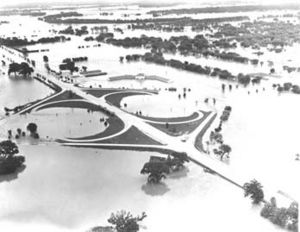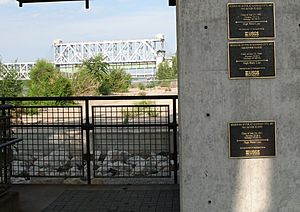Great Flood of 1951 facts for kids
In July 1951, very heavy rains caused huge floods in the Kansas River, Missouri River, and other rivers in the central United States. Areas in Kansas and Missouri were hit hard. The floods caused over $935 million in damage, which is a lot of money even today. Sadly, 17 people died, and 518,000 people had to leave their homes.
Contents
The Great Flood of 1951
The flooding actually started in May 1951. In Hays, a small river called Big Creek overflowed after 11 inches of rain fell in just two hours! The water was four feet deep in many parts of the town, especially near Fort Hays State University. Students and families living on campus had to quickly move to higher ground. All the school records were ruined, and graduation was delayed.
There were no warning sirens in Hays at the time. Two police officers drove through the streets, using their sirens and shouting for people to leave. They helped save many lives.
The floods got much worse in July 1951. Between July 9 and July 13, another 8 to 16 inches of rain poured down. The water levels reached their highest point since the Great Flood of 1844 and the flood of 1903. July 13 saw the worst of the flooding, causing the most damage ever seen in the Midwest up to that time.
It was so bad that the water levels in the Kansas River went above all the official measuring tools. Between Manhattan and Bonner Springs, the water was 4 to 6 feet higher than any previous record. Other rivers like the Marais Des Cygnes, Verdigris, and Neosho crested more than 9 feet above their old records.
The first places to be hit hard were Manhattan and Ft. Riley. Army buildings at the Fort were destroyed. In Manhattan, the downtown area was covered by 8 feet (2.4 m) of water, and two people died. Then, Topeka and Lawrence were also damaged. About 24,000 people had to leave Topeka.
In Kansas City, the floodwaters went over the protective walls (levees) in areas like Argentine and Armourdale. This forced 15,000 people to evacuate. Some houses in Armourdale had water up to their roofs. The flood also destroyed the Kansas City Stockyards, which were a big part of the city's economy. They never fully recovered. The flood also ruined the TWA airplane repair base at Fairfax Airport. This led to TWA moving to a new airport location, which later became Kansas City International Airport.
By July 13, over 1 million acres (4,300 km²) in Kansas and nearly 1 million acres (3,700 km²) in Missouri were flooded. The flood crest then moved downstream, causing more flooding in other cities like Boonville, Jefferson City, Hermann, and St. Charles, Missouri.
On July 17, President Harry Truman flew over the damaged areas. He said it was "one of the worst disasters this country has ever suffered from water."
River Flood Levels
Here are the highest water levels measured during the flood.
Kansas River Levels
| City | River crest | Height above flood stage | Date of measurement |
|---|---|---|---|
| Manhattan | 33.4 ft (10.2 m) | 15.4 ft (4.7 m) | July 13 |
| Wamego | 30.56 ft (9.31 m) | 11.6 ft (3.5 m) | July 13 |
| Topeka | 40.8 ft (12.4 m) | 14.8 ft (4.5 m) | July 13 |
| Lecompton | 30.23 ft (9.21 m) | 13.25 ft (4.04 m) | July 13 |
| Lawrence | 29.9 ft (9.1 m) | 11.9 ft (3.6 m) | July 13 |
| De Soto | 42.3 ft (12.8 m) | 16.3 ft (5.0 m) | July 13 |
Marais Des Cygnes River Levels
| City | River crest | Height above flood stage | Date of measurement |
|---|---|---|---|
| Ottawa | 42.97 ft (13.10 m) | 11.97 ft (3.65 m) | July 11 |
Neosho River Levels
| City | River crest | Height above flood stage | Date of measurement |
|---|---|---|---|
| Emporia | 33.4 ft (10.2 m) | 13.4 ft (4.1 m) | July 11 |
| Neosho Rapids | 34.3 ft (10.5 m) | 12.3 ft (3.7 m) | July 11 |
| Leroy | 34.48 ft (10.51 m) | 11.48 ft (3.50 m) | July 12 |
| Burlington | 41.53 ft (12.66 m) | 14.53 ft (4.43 m) | July 12 |
After the Flood
After the 1951 flood, many new levees (walls to hold back water) and reservoirs (large lakes for storing water) were built across eastern Kansas. These new flood control structures helped a lot when the region faced another big flood in 1993.
Before the 1951 flood, there were only five federal dams in the Kansas River area:
- Bonny Dam in Colorado
- Enders Dam and Medicine Creek Dam in Nebraska
- Cedar Bluff Dam and Kanopolis Dam in Kansas
More dams had been planned by the U.S. Army Corps of Engineers and the Bureau of Reclamation. These plans were approved by the Flood Control Act of 1944.
Since the 1951 flood, many more dams have been built. Now, a total of eighteen dams help control the flow of the Kansas River. Examples include Webster Dam and Kirwin Dam. Many other reservoirs and levees were also built in nearby river areas because of this flood.
In North Lawrence, there is a building shaped like a teepee. A mark on its side shows that the water was 7 feet high around the building during the flood.
In 2011, a painting about the flood called "Flood Disaster" by Thomas Hart Benton was sold for $1.9 million. Benton painted it at the time of the flood to help get money from Congress for flood relief.
Comparing to Other Big Floods
Over time, building channels and levees has changed how floods affect different areas along the Missouri River. Here's how the 1951 flood compares to other major floods:
- The Great Flood of 1844: This was the biggest flood in terms of how much water flowed per second in Kansas City. On July 16, 1844, the water crest was almost one foot lower than the 1993 flood.
- Great Flood of 1951: This flood had the second-highest water flow. The water crest on July 14, 1951, was almost 2 feet lower than the 1844 flood and 3 feet lower than the 1993 flood. However, it was the most damaging flood for Kansas City. This was because the city's levee system was not strong enough to handle it. It destroyed the city's stockyards and led to building a new airport away from the river.
- Missouri River Flood of 1952: The year after, flooding upstream on the Missouri River cut off the Rosecrans Memorial Airport from St. Joseph, Missouri. This was part of a larger series of floods affecting the entire Missouri River area.
- Great Flood of 1993: This flood had the highest water crest of the three, but the lowest water flow. Even though the 1993 flood caused huge damage elsewhere, Kansas City did relatively well. This was thanks to the improved levees built after the 1951 flood.



